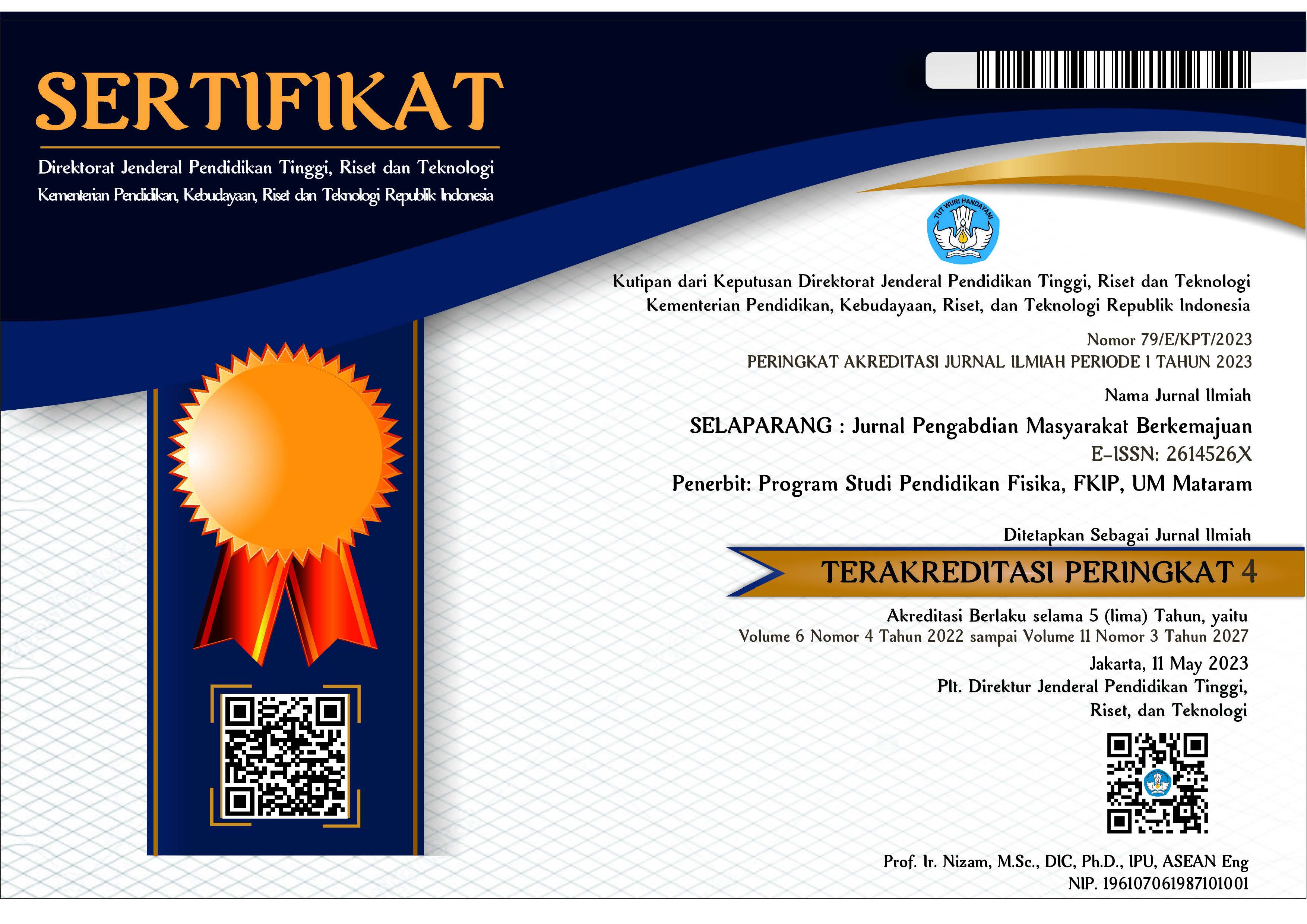PELATIHAN DAN PENDAMPINGAN PENERAPAN TEKNOLOGI SEL SURYA UNTUK PENGENTASAN MASALAH ELEKTRIFIKASI
Abstract
ABSTRAK
Energi listrik merupakan kebutuhan dasar bagi masyarakat pada modern sekarang ini, dimana keberadaanya sangat mempengaruhi berbagai sendi kehidupan. Keterbasan dalam penyaluran energi listrik disebabkan oleh faktor geografis yang sulit dijangkau mempengaruhi peningkatan biaya investasi dalam pemasangan instalasi dan distribusi jaringan listrik. Tujuan dari pengabdian ini yaitu mengidentifikasi tingkat kebutuhan energi listrik dan memberikan sosialisasi serta penyuluhan kepada masyarakat mengenai Teknologi Tepat Guna (TTG) sel surya. Upaya yang dilakukan adalah dengan penerapan energi terbarukan melalui konversi sumber energi matahari menjadi energi listrik secara langsung yang merupakan solusi alternatif dalam pemenuhan kebutuhan energi listrik sehari-hari untuk daerah-daerah yang belum terjangkau jaringan listrik PLN. Metode yang digunakan untuk penerapan teknologi sel surya ini dilakukan melalui kegiatan pelatihan, penyuluhan dan pendampingan kepada masyarakat di sekitar Desa Muara Enggelam, Kabupaten Kutai Kartanegara. Hasil dan kegiatan ini menunjukkan bahwa masyarakat memperoleh wawasan dan kemampuan dalam mengoperasikan teknologi sel surya. Selain itu kegiatan ini juga menghasilkan prototipe Teknologi Tepat Guna (TTG) yang kompatibel, berdaya guna, dan mudah dioperasikan bagi pengguna listrik DC, AC dan gabungannya (DC+AC) untuk pemenuhan kebutuhan listrik sehari-hari. Penerapan jangka panjang dari prototipe TTG ini perlu dilakukan kajian, baik terkait kelayakan kinerja teknologi sel surya yang melibatkan banyak faktor maupun kajian kelayakan secara ekonomi terkait pembiayaan teknologi sel surya ini.
Kata kunci: : energi listrik; energi matahari; sel surya; prototipe TTG; kelayakan.
ABSTRACT
Electrical energy is a basic need for people in today's modern society, where its existence greatly affects various aspects of life. Limitations in the distribution of electrical energy caused by geographical factors that are difficult to reach affect the increase in investment costs in the installation and distribution of electricity networks. The purpose of this service is to identify the level of electrical energy needs and provide socialization and counseling to the community regarding appropriate technology (TTG) solar cells. The effort made is the application of renewable energy through the conversion of solar energy sources into electrical energy directly which is an alternative solution in meeting daily electrical energy needs for areas that have not been reached by the PLN electricity network. The method used for the application of solar cell technology is carried out through training, counseling and mentoring activities for the community around Muara Enggelam Village, Kutai Kartanegara Regency. The results and activities showed that the community gained insight and ability to operate solar cell technology. In addition, this activity also produced a prototype of Appropriate Technology (TTG) that is compatible, effective, and easy to operate for users of DC, AC and combined electricity (DC + AC) to fulfill their daily electricity needs. The long-term application of this TTG prototype needs to be studied, both related to the feasibility of solar cell technology performance involving many factors and economic feasibility studies related to the financing of this solar cell technology.
Keywords: electrical energy; solar energy; solar cell; TTG prototype; feasibility.
Keywords
Full Text:
PDFReferences
Bayrak, F., Ertürk, G., & Oztop, H. F. (2017). Effects of partial shading on energy and exergy efficiencies for photovoltaic panels. Journal of Cleaner Production, 164, 58–69. https://doi.org/10.1016/j.jclepro.2017.06.108
Badan Pusat Statistik, Kabupaten Kutai Kartanegara, BPS, 2021.
Dhiman, B., Kumar, T., Rituraj, G., Bhalla, K., & Chakrabarti, D. (2019). Study of small scale photovoltaic applications in rural Indian household context. Journal of Physics: Conference Series, 1343(1), 012095. https://doi.org/10.1088/1742-6596/1343/1/012095
El-houari, H., Allouhi, A., Rehman, S., Buker, M. S., Kousksou, T., Jamil, A., & El Amrani, B. (2019). Design, Simulation, and Economic Optimization of an Off-Grid Photovoltaic System for Rural Electrification. Energies, 12(24). https://doi.org/10.3390/en12244735
Fakher Alfahed, R. K., Oudah, S., & Al-jabori, K. (2019). Electrification of a Rural Home by Solar Photovoltaic System in Haur Al-Hammar of Iraq. Journal of Energy Management and Technology, 3(3), 30–40. https://doi.org/10.22109/jemt.2018.134845.1102
Ghaib, K., & Ben-Fares, F.-Z. (2017). A design methodology of stand-alone photovoltaic power systems for rural electrification. Energy Conversion and Management, 148, 1127–1141. https://doi.org/10.1016/j.enconman.2017.06.052
Hiendro, A., Kurnianto, R., Rajagukguk, M., Simanjuntak, Y. M., & Junaidi. (2013). Techno-economic analysis of photovoltaic/wind hybrid system for onshore/remote area in Indonesia. Energy, 59, 652–657. https://doi.org/10.1016/j.energy.2013.06.005
Iqbal, A., & Iqbal, M. T. (2019). Design and Analysis of a Stand-Alone PV System for a Rural House in Pakistan. International Journal of Photoenergy, 2019, 4967148. https://doi.org/10.1155/2019/4967148
Minaei, F., Minaei, M., Kougias, I., Shafizadeh-Moghadam, H., & Hosseini, S. A. (2021). Rural electrification in protected areas: A spatial assessment of solar photovoltaic suitability using the fuzzy best worst method. Renewable Energy, 176, 334–345. https://doi.org/10.1016/j.renene.2021.05.087
Van Sark, W. (2019). Photovoltaic System Design and Performance. Energies, 12(10). https://doi.org/10.3390/en12101826
Wang, D., Qi, T., Liu, Y., Wang, Y., Fan, J., Wang, Y., & Du, H. (2020). A method for evaluating both shading and power generation effects of rooftop solar PV panels for different climate zones of China. Solar Energy, 205, 432–445. https://doi.org/10.1016/j.solener.2020.05.009
DOI: https://doi.org/10.31764/jpmb.v7i4.19814
Refbacks
- There are currently no refbacks.

This work is licensed under a Creative Commons Attribution-ShareAlike 4.0 International License.
______________________________________________________
Jurnal Selaparang
p-ISSN 2614-5251 || e-ISSN 2614-526X
EDITORIAL OFFICE:



















